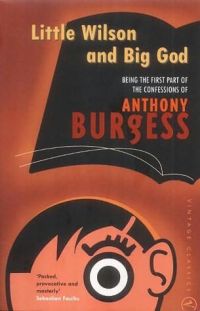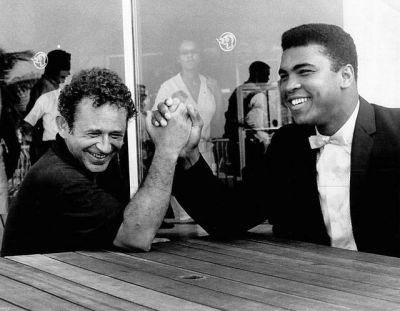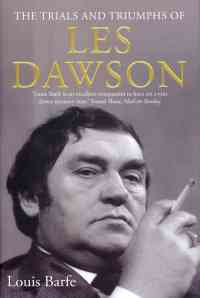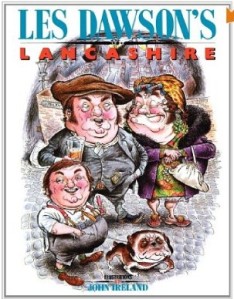 Little Wilson and Big God: Being the First Part of the Confessions of Anthony Burgess, Anthony Burgess (1986)
Little Wilson and Big God: Being the First Part of the Confessions of Anthony Burgess, Anthony Burgess (1986)
Mancunians will forgive any faux pas but one: success. In the 1960s and ’70s, the author of A Clockwork Orange became a core component of the M.M.F.T.M.(T.C.) community: Mooch More Famous Than Me (The Coont). In the 1980s, Morrissey would join him, but the two Mancunians already had two big things in common: music and Irish Catholicism. Music is how Mozza made his name and how Buzza originally wanted to make his. Mozza is I.C. on both sides, Buzza was I.C. on one, the side of his birthname, that of the Wilsons:
They did odd jobs, sang and danced, joined foreign armies and disappeared into Belgium, migrated to Dublin, came back with Irish wives. There was a regular tradition of marrying into Ireland, which meant often into Irish families that had taken the boat from Queenstown to Liverpool and wandered inland to Manchester. I ended up as more of a Celt than an Anglo-Saxon. My father broke the tradition by marrying a Protestant of mainly Scottish ancestry – Lowland, hence Anglo-Saxon – but he married her in a church with a Maynooth priest and she converted easily. (pg. 9)
She died easily too, swept away with Burgess’s older sister Muriel in the epidemic of influenza with which Mother Nature reasserted herself after the clumsy, man-made slaughter of the First World War. Whatever man can do, Ma can do better. Arbitrary loss and natural evil are important themes of Burgess’s fiction, but death didn’t just shape his writing: it made him a writer. Given a year to live in 1959, after the diagnosis of an inoperable brain tumour, he set about creating a pension for his wife:
I did not really believe this prognosis. Death, like the quintessence of otherness, is for others. But if the prognosis was valid, then I had been granted something I had never had before: a whole year to live. I would not be run over by a bus tomorrow, nor knifed on the Brighton racetrack. I would not choke on a bone. If I fell in the wintry sea I would not drown. I had a whole year, a long time. In that year I would have to earn for my prospective widow. No one would give me a job… I would have to turn myself into a professional writer… (pg. 448)
It’s a good way to end a highly readable autobiography, which might be called a B.B. book: Before Burgess, before fame. You’ve Had Your Time (1990), the highly readable sequel, is A.B., After Burgess, after John Wilson made his dead mother’s maiden name internationally famous. But he never forgot his roots:
I am proud to be a Mancunian. I have, after a struggle with a people given to linguistic conservatism, even succeeded in importing the epithet mancuniense into the Italian language… and, lecturing in Rome, I have declared myself a cittadino mancuniense, cioè romano. At the time of my birth, Manchester was a great city, Cottonopolis, the mother of liberalism and the cradle of the entire industrial system. It had the greatest newspaper in the world, meaning the only independent one. The Manchester Guardian debased itself when it grew ashamed of the city of its origin: a superb liberal organ was turned into an irritable rag dedicated, through a fog of regular typographical errors that would have appalled C.P. Scott, to the wrong kind of radicalism. (pg. 15)
That showing-off and opinionated self-importance is characteristically Burgessian, but self-importance isn’t unknown among other Mancunians. You can learn a lot about the northern inferiority complex from this book and about the refinement of it that came with being both northern and Catholic. But Burgess is right to resent certain things. He was always a better and more interesting writer than the southerner Graham Greene, a convert who thought Burgess’s “cradle Catholicism was suspect” (pg. 418). He wasn’t a better writer than the convert Evelyn Waugh, but some of his best writing was inspired by Waugh. The very funny, but also sinister, misunderstanding in The Enemy in the Blanket (1958), the second book of Burgess’s Malayan Trilogy, is obviously Wauvian, but with Burgessian embellishments: it involves an edentate Chinese cook, a cat, and a kitchenmaid, and hinges on the ambiguity of the Malay verb makan, which can mean both “to eat” and “to fuck”.
Burgess says that “the Malay language, and later the Chinese, changed … the whole shape of my mind” (pg. 371), but his fascination with language and languages began well before his encounter with the polyglot gallimaufrey of Malaya. As a child, he was attracted to the exotic French on the label of an H.P. sauce bottle. But he also heard exotic language from his family:
My grandfather would say, if [his wife] Mary Ann had a headache, “Oo’s gotten ’eed-warch.” The “oo” is Anglo-Saxon heo and the “warch” is from weorc. He would translate this for foreigners as “She’s got a headache”, but Lancashire phonemes would cling to the straight English. So, for a long time, with myself. I regret the death of the dialect, which was once a literary medium: Sir Gawain and the Green Knight comes from the Wirral peninsula and would have been intelligible to the mediaeval Wilsons… Since the provincial revolt of the 1950s, the Lancashire accent, especially in its Liverpool form, has become acceptable in the wider world, but the dialect itself is nearly dead. It has no orthography, and there is no literary tradition to elevate it. (pg. 11)
This is another of Burgess’s losses: to have lived long, as he did, is to have lost much. Not just his mother: his mother-tongue too. But the dialect, “automatically comic” in England’s “centralising linguistic culture”, lingered into his adulthood. After the war he moved to the hamlet of Bamber Bridge near Priest-Town Preston. His first wife Lynne could not understand what she was asked when she went into a pub during heavy rain: “Art witshet?” Lancashire lad Burgess could translate this as “Art thou wet-shod?” (pg. 347) Through Lynne, whom he had met while both were students at Manchester University, he encountered another disappearing linguistic tradition. She was Anglo-Welsh and her full name was Llewela Isherwood Jones:
Llewela is the feminine form of Llewelyn. It has noble leonine connotations, but to the students of Manchester it was a joke. The English always have trouble with the Welsh unvoiced lateral unless, like me, they have studied phonetics… Llewela solved the problem for the Sais [i.e., the Saxons] by borrowing the masculine termination and calling herself Lynne. (pg. 208)
But she wasn’t a Cymric incarnation of Burgess’s “darkly Mediterranean” erotic ideal: she was “a tall athletic girl, blonde and blue-eyed, with a superbly developed body” (pg. 206). One of Burgess’s most famous books, Earthly Powers (1980), is about a homosexual writer based on Somerset Maugham; one of his most memorable characters is a homosexual Malay called Ibrahim in Time for a Tiger (1956). But Burgess said book and character were exercises in imaginative sympathy: he never felt inclined that way. If Little Wilson and Big God is anything to go by, he didn’t have time. When he wasn’t studying phonetics, composing symphonies, or translating menus into Latin, he was seeking or shagging women. This is the metaphor he chooses to sum up his introduction to Asia:
I wandered Singapore and was enchanted. I picked up a Chinese prostitute on Bugis Street. We went to a filthy hôtel de passe full of the noise of hawking and spitting, termed by the cynical the call of the East. I entered her and entered the territory. (Part 5, pg. 373)
There’s lots of lechery in this book. And lots of literature, but Burgess didn’t always acquire it in the conventional way. Although his degree would be in English Literature, his first love was music:
In school essays I would refer to the Mozartian limpidity of Addison’s prose or the Wagnerian richness of Thomas de Quincey… I was the only one in a French lesson to be able to say what a casse-noisette was, thanks to Tchaikovsky. I also knew the Faust legend, because of Gounod and Busoni, and could read Cyrillic, having studied in Manchester Central Library the original score of Le Sacre du Printemps. Asked to compare the styles of Tennyson’s “Ulysses” and “The Lotus Eaters”, I said one had the austerity of Sibelius and the other the sensuousness of the Venusberg music in Tannhäuser. What I should have said was that one was in blank verse and the other rhymed. (pg. 115-6)
Autodidactism and showing-off: Burgess began both early. He describes composing a symphony in 1934, in his late teens:
The writing of a three-hundred-page musical work is more laborious than the merely literary person is able to appreciate. You can spend four hours scoring a passage which, in fast tempo, may take only a few seconds to perform. The ring finger of my right hand is permanently deformed with the strain of writing that one work alone. It was a highly juvenile work, and the Luftwaffe, in the name of Beethoven, to say nothing of Wagner, was probably right to destroy it in 1941. (pg. 159)
That “merely literary” is a dig at the southern literary establishment, which Burgess felt never accepted him or properly acknowledged his talent. But he didn’t devote much of that talent to writing about the war that destroyed his symphony. It wasn’t the overpowering experience people who didn’t live through it sometimes imagine: it had been anticipated for years and Burgess seems to have spent his military service being buggered about and being a difficult bugger. After yet another brush with authority he remarks: “I felt, as often before, that I was marked” (pg. 275). But he saw no fighting and ran no great risk of death, unlike some of his fellow students at university:
Poor as I was, however, I still insisted on the Friday night booze-up, with Gaunt and Mason and two men from the English second year called Ian McColl and Harry Green. Green and McColl fascinated me. They were coarse, rejecting totally the grace of civilisation, but the English language and its literature were their life. McColl was so soaked in Anglo-Saxon that it was a natural instinct for him to avoid Latinisms and Hellenisms even in colloquial speech. He was quite prepared, like the poet Barnes, to call an omnibus a folk wain or a telephone a fartalker. He knew German but hated the Nazis, who, after all, were only disinfecting their language of exoticisms in McColl’s own manner. He and Green knew there was a war coming, and they did regular infantry drill with the university Officer Training Corps. They were both killed in France in 1940, following the tradition of First World War subalterns, and this they were perhaps prepared to foresee. They never spoke of a future; they were fixed in a present of which the literary past was a part. McColl composed orally an endless saga about two lecherous boozers called Filthfroth and Brothelbreath … Green, outside a pub in the Shambles [a district in Manchester] called The White Horse, exclaimed at the ancient rune [Þ], which the Normans replaced with a digraph, in the definite article. In some arty antique signs, like those outside county town teashops, that rune appears as a Y, but it did not here. “Christ,” Green cried, “they’ve got a proper fucking thorn.” (Part 3, pg. 198-9)
Would McColl and Green have become famous if they had survived the war? Perhaps not, but Burgess manages to “embalm” their “poignant history” in “the magical spices of words”, as Lytton Strachey said of another autobiographer, Cardinal Newman. If Burgess had not memorialized them, they, their “Filthfroth” and “fucking thorn” might now be entirely forgotten: two new-lit candles blown out more than seventy years ago by the breath of Mars. Earlier in the book, Burgess has described a lost photograph of his mother and sister, who both died while he was still a baby. It was “long since eaten up by Malayan humidity and termites” (pg. 16). The photograph had gone; his memory of it remained; now there is just the description of the memory in a book. McColl and Green are one step nearer reality: remembered and recorded from life. Burgess saved a crumb or two of their mortality from Edax Tempus, Devouring Time, and that is part of the value of this book. It’s about a famous man before he became famous and saves many crumbs from his own and other people’s ordinary lives. But he obviously wanted fame: when he stole “pass-forms” during the war and forged signatures to go on illegitimate leave, he used names like “J. Joyce, E. Pound, E.M. Forster, Lieut for Major” (pg. 281), knowing that they were unlikely to rouse suspicion in the philistine army.
That first forgee is particularly important: Burgess spent the war seeking strength through Joyce, whom he’d first been bedazzled by before the war. “Ironically”, however, the hell-sermons of A Portrait of the Artist as a Young Man (1916) had frightened him back to faith: “I ran to the confessional, poured out my sins of doubt almost sobbing, and received kind absolution and a nugatory penance” (pg. 141). I can’t take the same jouissance in Joyce, but Burgess followed him faithfully from the fairly conventional Portrait through the deepening experimentation of Ulysses (1922) into the poly-performative linguistic maelstrom of Finnegans Wake (1939), which “impressed” the unliterary Lynne “only because the apparent typing chimpanzees had put me into it as ‘J.B.W. Ashburner’” (pg. 215) – John Burgess Wilson used to visit her at Ashburne Hall, a female hall of residence at Manchester University. I can’t say how happy Joyce’s influence has been on Burgess’s writing, but it did sometimes get a little silly. In “The Oxen of the Sun” episode of Ulysses, Joyce used older forms of English to create “a series of literary parodies which serve the representation of the growth of the embryo in the womb”. Of his Wagnero-Joycean novel The Worm and the Ring (1960), Burgess says:
In describing the adulterous act of my hero Howarth-Siegfried and Hilda on a school excursion to Paris, I tried to go further than Joyce by hiding the shameful deed in a kind of reversed history of French prose style, with the Strasbourg Oath collapsing into Latin at the moment of climax. This had nothing to do with the Ring of the Nibelungs: it was sheer literary self-indulgence. (pg. 368)
You said it, Buzza. His attempt to “go further” than Joyce reminds me of a scene in the Comic Strip’s “Bad News Tour” (1983), a heavy-metal mockumentary in which a guitarist boasts of having learnt “Stairway to Heaven” when he was only twelve, even though Jimmy Page didn’t write it till he was twenty-two. Burgess undoubtedly had no time for Led Zeppelin, though he contributed strongly, if inadvertently, to the counter-culture with at least one book: the Led Zeppelin drummer Bonzo would be dressing up as a “droogie” after Stanley Kubrick filmed A Clockwork Orange in the 1970s. And Burgess may never have heard of the Smiths and Morrissey, that later Mancunian who committed the cardinal sin of rising to international fame. It’s interesting to wonder what would have happened if the two had been swapped at birth, Morrissey being sent back in time and Burgess brought forward. The art of both is rooted firmly in northern England, but Burgess’s tendrils wandered much further: he’s right to contrast Maugham’s Anglo-centric Malayan fiction with his own, which drew on all races of the region and mingled all their languages. Morrissey has written about Hispanic gang-members and sexual encounters in Rome, but he’s never tried to translate The Wasteland into Malay.
For Burgess’s full discussion of A Clockwork Orange, you’ll have to look at part two of the autobiography, You’ve Had Your Time, but Burgess’s post-war, pre-independence days in Malaya are fully covered in this, part one. They inspired the Malayan Trilogy, which contains some of his best, funniest, and richest writing, and he says they killed Lynne, who became an alcoholic there through boredom and acquired anaemia because of the climate. Burgess ends the book meditating on the irony of trying to earn money for a wife who would die long before him. He begins it in the middle of the 1980s, meditating in New York on his own survival and the endless struggle he has had with the English language: “Mastery never comes, and one serves a lifelong apprenticeship. The writer cannot retire from the battle; he dies fighting. This book is another battle.” (pg. 6)
Burgess did die fighting and although he never wrote as well as Waugh, very few people have and Waugh did not mix so many ingredients with such gusto into his writing. Little Wilson and Big God doesn’t have the elegance or elegy of A Little Learning, Waugh’s slender essay in autobiography, but I’ve read both books several times and hope to read both again. Burgess’s is much longer and you’ll laugh more and learn more: he always retained an outsider’s fascination with the strangeness of human beings and their languages. The larger strangeness of mathematics and science passed him by, as it did Waugh, and phonetics was as close as he got to science. Burgess’s experiences during the war weren’t as powerful as those of J.G. Ballard, who spent it in a Japanese detention camp, rather than teaching English on the Rock of Gibraltar as Burgess did, but both writers were influenced by a hotter sun and spicier air. One was born east and came west, the other was born west and went east: that shared experience means that their fiction has an un-English richness and extravagance. Ballard’s literary flight, fuelled on science and psychosis, will last longer, but Burgess is in some ways more entertaining and is certainly funnier. There’s Lancashire music-hall in this book, with Catholic guilt, northern chippiness, and some of the “old sharp flavours” of English life that the rising tide of Americanization and standardization would soon wash away. And much more beside, from rejections by T.S. Eliot and pub-encounters with George Orwell to cats feasting on snakes in Borneo and dicing with death driving through the Malay jungle. As introduction to Burgess or explication for his fans, I’d call it doubleplusgood.
Proviously post-posted on Papyrocentric Performativity:
•
Lesser Letters — review of
You’ve Had Your Time: Being the Second Part of the Confessions of Anthony Burgess, Anthony Burgess (1990)
Read Full Post »






